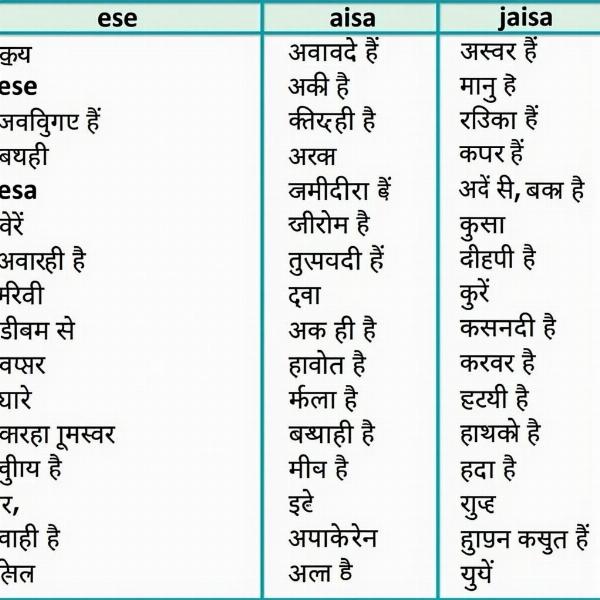Understanding the meaning of “ese” can be tricky, especially when navigating the nuances of Hindi. This guide will delve into the various interpretations and contexts of “ese” meaning in Hindi, providing clear examples and practical applications to help you grasp its usage. We’ll explore how “ese” relates to similar words and phrases, offering a comprehensive understanding of its significance in different conversational settings.
Decoding “Ese” in Hindi
“Ese” in Hindi doesn’t have a direct, one-word translation. It’s more of a demonstrative pronoun, similar to “this” or “these” in English, but with added contextual flavors. Its meaning hinges heavily on the situation and the accompanying words. Often, it indicates something nearby or something previously mentioned. Think of it as a linguistic pointer, directing attention to a specific object, action, or concept.
Common Usages of “Ese”
- Referring to objects: “Ese kursi” (ऐसे कुर्सी) translates roughly to “this chair” or “a chair like this.” Notice how the meaning becomes more specific with the addition of “kursi” (chair).
- Describing actions: “Ese karo” (ऐसे करो) means “do it like this” or “do it this way.” Here, “ese” clarifies the manner of the action.
- Indicating similarities: “Ese hi” (ऐसे ही) translates to “like this” or “just like this,” often used to express similarity or agreement.
“Ese” vs. Other Similar Words
Understanding how “ese” differs from similar Hindi words like “aisa” (ऐसा), “vaisa” (वैसा), and “jaisa” (जैसा) is crucial for accurate usage. While they all share a demonstrative function, they carry distinct connotations. “Aisa” generally means “like this” or “such,” while “vaisa” means “like that” or “that kind of.” “Jaisa” implies “as” or “like,” often used in comparisons. “Ese,” however, is more immediate and less specific, pointing to something in the present context.
Examples to Illustrate the Differences:
- Ese: “Ese mat karo!” (Don’t do it like this!) – Immediate and specific to the action being performed.
- Aisa: “Aisa mausam mujhe pasand hai.” (I like this kind of weather.) – More general, referring to the type of weather.
- Vaisa: “Vaisa khana mat khao.” (Don’t eat that kind of food.) – Referring to a specific type of food, possibly distant or not present.
- Jaisa: “Jaisa tum karoge, vaisa hi hoga.” (As you do, so shall it be.) – Used for comparison and consequence.
 Ese vs. Other Hindi Words
Ese vs. Other Hindi Words
Using “Ese” in Different Contexts
The versatility of “ese” allows for its use in a wide range of conversational scenarios. From giving directions to expressing emotions, “ese” adds a layer of immediacy and clarity. Imagine you’re teaching someone a new skill. You might say, “Ese pakdo” (ऐसे पकड़ो), meaning “Hold it like this.” This demonstrates the practical application of “ese” in everyday communication.
Formal vs. Informal Usage
While “ese” is commonly used in informal settings, it can also appear in more formal contexts, especially in literature or poetry. However, in formal situations, using more specific words like “is prakar” (इस प्रकार) – meaning “in this way” – might be preferred.
Conclusion
Understanding the nuances of “ese meaning in hindi” enhances your grasp of the language and allows for more effective communication. By recognizing its contextual usage and differentiating it from similar words, you can confidently navigate various conversational situations. Remember, “ese” acts as a linguistic pointer, adding a layer of immediacy and clarity to your expressions.
FAQs
- Is “ese” always used as a demonstrative pronoun? Generally, yes. However, its exact meaning is always context-dependent.
- Can I use “ese” in formal writing? While possible, more formal alternatives like “is prakar” are often preferred.
- What’s the difference between “ese” and “aisa”? “Ese” is more immediate, pointing to something in the present context, while “aisa” is more general.
- How do I know which word – “ese,” “aisa,” “vaisa,” or “jaisa” – to use? Pay attention to the context and the specific nuance you want to convey.
- Are there any other words similar to “ese”? Yes, words like “is tarah” (इस तरह) also mean “in this way” or “like this.”
Meaning-Hindi.in: Your Trusted Partner for Hindi Translations
Meaning-Hindi.in provides expert Hindi translation services, catering to diverse needs from business documents and legal papers to technical manuals and website localization. We also offer specialized services for educational and academic materials, ensuring accurate and culturally sensitive translations. Need a quick turnaround? Our express translation service is designed to meet tight deadlines without compromising quality. Contact us today for professional Hindi translation solutions tailored to your specific requirements.
Email: [email protected]
Phone: +91 11-4502-7584
Connect with Meaning-Hindi.in for all your Hindi translation needs!